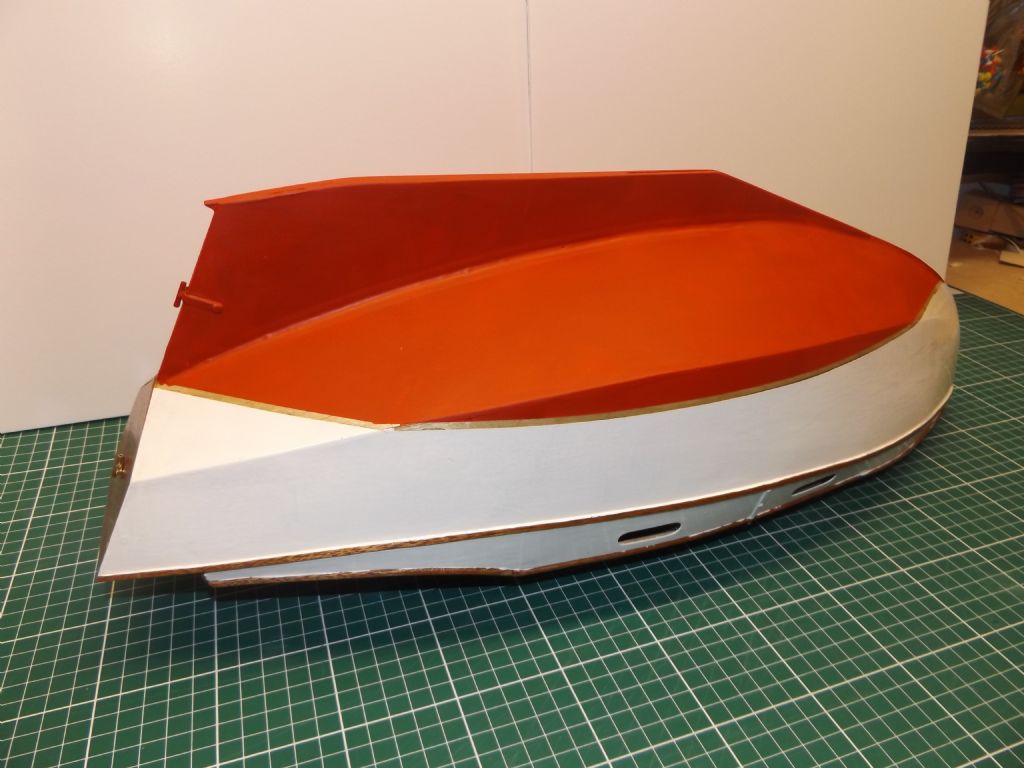John,
Glad to hear that progress is being made! 
The classic trick for at least making seeping paint slightly less likely is to "seal" the edge of the masking tape with a small amount of the previous paint, i.e. that pant that sits under the masking tape. In the instance you've just come out of, before applying the red/brown bottom paint, you would have painted along the tape with primer once or twice. Not thickly, just enough to as it were pre-seep with primer in any spots where that would be likely to happen.
However, from your description, it sounds as though you will mask off the same line twice, once from above and once from below? In my opinion it would have been better to not bother with masking off for the bottom paint, but just to paint it on to a little bit higher than the actual water line, then to mark out the water line with a pencil on a block of wood and mask off along that line from below and finally to paint on the black topside colour.
That way, you only have to mask off once; also you don't have to make the second masking match the first.
If, as you describe it, you had to fold the masking tape in on itself to make it follow the curvature, it does, I'm afraid, sound to me as though you've used too wide a masking tape, which is rather an open invitation to seepage.
What sort and width of tape did you use?
Personally, when masking off waterlines, I prefer to do the actual edge with a 2 or 3 mm wide tape, as that will be flexible enough to follow the curvature while still lying perfectly flat. My preferred such narrow tapes I get from a place in the Netherlands called Airbrush Services Almere, where it is labelled as "washi microtape" but without any brand name (**LINK**).
It would, I dare say, be a tad over the top to send off for these from The Netherlands all the way to Australia, not least because a quick dry-run through their webshop shows that the p&p would be around $35 (!), but if you'd like to try some, I'd be happy to reel off a meter or so of each width and send it to you.
Anyway, when masking I will next build up the masked off area by a second round with 6 or 10 mm Tamiya tape, overlapping the washi, and sometimes add yet one more round of 18 mm Tamiya. If even more masking is required (it usually is when airbrush painting) I will use clingfilm and/or some other form of plastic sheet and/or a less expensive house painting masking tape. I never use newspapers for masking off in touch with a surface, as there's always a risk that the ink will smear.
Finally, yes, you can make paint lighter by adding white, although it is not a straight-forward process; the (dark) art of mixing colours is still a bit of a mystery to me, but other options might include mixing with lighter browns (siennas for instance) or even yellow. The best way forward is to simply experiment!
Mixing two brands of model acrylics should in principle be possible, although there may be incompatibilities, either between the mediums or the thinners used; however, I would be quite surprised if you had a problem mixing two different brands of water based model acrylics. Again, if you have the paints to hand: do a test piece! If you need to send off for one of the mix ingredients, I'd stick with the same brand just to be on the safe side.
Mattias
Edited By Banjoman on 08/03/2018 06:47:41


 , 8 on the bowsprit (although only 4 seem to be used – the ones on the sides which should have a line to each side of the hull aren'r shown to be rigged), 5 on the foremast (although there are 4 others drawn in the diagram but not labeled). That makes 29. There appears to be another 5 on the main mast but not labeled even though there is rigging on them and 1 labeled at the end of the foresail boom so that totals 35 labeled and another 5 on the main mast not labeled.
, 8 on the bowsprit (although only 4 seem to be used – the ones on the sides which should have a line to each side of the hull aren'r shown to be rigged), 5 on the foremast (although there are 4 others drawn in the diagram but not labeled). That makes 29. There appears to be another 5 on the main mast but not labeled even though there is rigging on them and 1 labeled at the end of the foresail boom so that totals 35 labeled and another 5 on the main mast not labeled.



